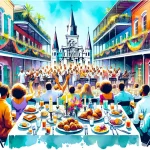The Allstate Sugar Bowl, a New Year’s Day tradition since 1935, has become a cornerstone of college football and a cherished part of New Orleans culture. As one of the oldest and most prestigious bowl games in the nation, the Sugar Bowl attracts fans from across the country to witness top-tier teams compete for glory in the iconic Caesars Superdome.
In This Article
TL;DR
- The Sugar Bowl is a premier college football event featuring elite teams from major conferences or serving as a College Football Playoff Semifinal.
- Planning your visit involves securing tickets, accommodations, transportation, and familiarizing yourself with the venue and local traditions.
- Embracing New Orleans‘ unique culture, attending side events, and utilizing technology can elevate your overall Sugar Bowl experience.
Historical Significance of the Sugar Bowl
The Sugar Bowl’s origins date back to 1935 when Fred Digby, a New Orleans sportswriter, envisioned a football game that would rival the Rose Bowl. Since then, the Sugar Bowl has hosted numerous legendary coaches, players, and teams, cementing its status as a pillar of college football.
Over the years, the Sugar Bowl has been the stage for many unforgettable moments, such as the 1973 game between Notre Dame and Alabama, which ended in a thrilling 24-23 victory for the Fighting Irish. The Sugar Bowl has also played a crucial role in determining national championships, with the game often featuring the top-ranked teams in the nation.
Planning Your Visit to the Sugar Bowl
To ensure a smooth and enjoyable experience, it’s essential to plan your visit well in advance. When purchasing tickets, consider factors such as seat location and price. Tickets can be bought through the official Sugar Bowl website or secondary marketplaces like StubHub or SeatGeek.
When choosing accommodations, proximity to the Caesars Superdome and the French Quarter is a significant advantage. Hotels like the Hyatt Regency New Orleans, the InterContinental New Orleans, and the Hilton New Orleans Riverside offer convenient access to the stadium and nearby attractions. Book early to secure the best rates and availability.
For transportation, consider using the New Orleans Regional Transit Authority (RTA) bus and streetcar system, which provides service to the Superdome. Ridesharing services like Uber and Lyft are also popular options, but be prepared for potential surge pricing and traffic congestion on game day.
Understanding the Venue: The Caesars Superdome
The Caesars Superdome, formerly known as the Mercedes-Benz Superdome, is an architectural marvel and an iconic part of the New Orleans skyline. Built in 1975, the stadium has hosted numerous high-profile events, including seven Super Bowls and four BCS National Championship games.
During the Sugar Bowl, visitors can expect a range of amenities, including concession stands offering classic stadium fare and local favorites, restrooms, and merchandise kiosks. To navigate the venue efficiently, familiarize yourself with the stadium’s layout and entry points, which are clearly marked and staffed by helpful event personnel.
Engaging with Local Culture During Sugar Bowl Season
New Orleans is a city recognized for its distinctive culture, and the Sugar Bowl season is an excellent time to immerse yourself in the local traditions. From indulging in classic Creole and Cajun cuisine at restaurants like Dooky Chase’s, Galatoire’s, or Commander’s Palace, to exploring the historic French Quarter and its lively street performances, there’s no shortage of ways to experience the city’s unique charm.
When interacting with locals, embrace the friendly and hospitable nature of New Orleanians. Don’t be afraid to strike up conversations, ask for recommendations, or join in on the festivities. Just remember to be respectful of local customs and traditions, and always prioritize safety in large crowds.
Sugar Bowl Festivities and Side Events
In addition to the main event, the Sugar Bowl season features a variety of official and unofficial festivities that add to the excitement. One of the most popular traditions is the Sugar Bowl Parade, which takes place on New Year’s Eve and features colorful floats, marching bands, and costumed performers.
Other notable events include the Fan Fest, which offers interactive exhibits, live entertainment, and meet-and-greets with college football legends, as well as the New Year’s Eve Celebration in Jackson Square, a free public event with live music and a midnight fleur-de-lis drop.
To make the most of your Sugar Bowl experience, consider attending these side events while also allowing ample time for game day activities. Plan your itinerary in advance, but be flexible enough to accommodate spontaneous opportunities for fun and celebration.
Safety and Security at the Sugar Bowl
The safety and security of attendees are top priorities for Sugar Bowl organizers and local authorities. The Caesars Superdome employs a range of security measures, including metal detectors, bag checks, and a clear bag policy to ensure a safe environment for all visitors.
To stay safe in large crowds, be aware of your surroundings, keep valuables secure, and follow the instructions of stadium personnel and law enforcement. In case of emergencies, know the location of first aid stations and exits, and have the contact information for local emergency services readily available.
Leveraging Technology for a Better Experience
To enhance your Sugar Bowl experience, take advantage of the various digital resources available. The official Sugar Bowl app provides real-time updates on game day, including scores, stats, and exclusive content. The Caesars Superdome also offers mobile ticketing and cashless payment options for added convenience.
Engage with the Sugar Bowl community on social media platforms like Twitter, Facebook, and Instagram, using official hashtags to share your experiences and connect with fellow fans. Be sure to follow the official accounts of the participating teams and the Sugar Bowl for the latest news and updates.
Expert Insights and Additional Resources
To gain a deeper understanding of the Sugar Bowl’s significance and impact, seek out the perspectives of those who have experienced the event firsthand. Reach out to alumni associations, local sports journalists, or long-time New Orleans residents for their insights and stories.
For further reading, explore books like “Sugar Bowl Classic: A History” by Marty Mulé and “The Allstate Sugar Bowl Story” by Ron Higgins, which offer detailed accounts of the game’s rich history and cultural importance.
As you prepare for your visit, stay informed about any changes or announcements related to the event by regularly checking the official Sugar Bowl website and following local news outlets. By staying up-to-date and well-informed, you’ll be better equipped to navigate the excitement and energy of the Sugar Bowl season in New Orleans.






